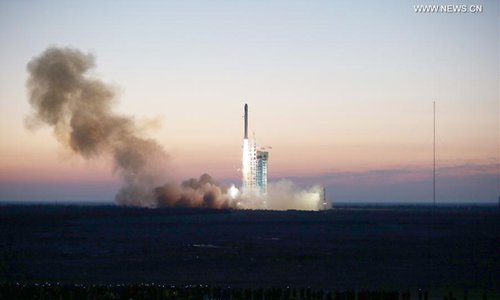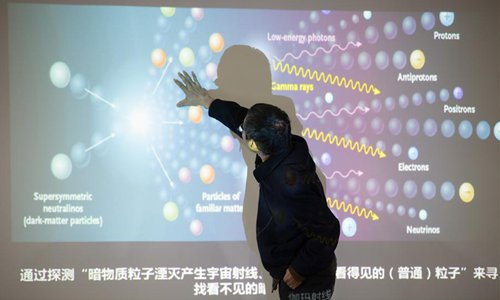
Photo taken on Dec. 17, 2015 shows a Long March 2-D rocket carrying the Dark Matter Particle Explorer satellite blasting off. China's Dark Matter Particle Explorer (DAMPE) has detected unexpected and mysterious signals in its measurement of high-energy cosmic rays, which might bring scientists a step closer to shedding light on invisible dark matter. The satellite, also called Wukong, or Monkey King, has measured more than 3.5 billion cosmic ray particles with the highest energy up to 100 tera-electron-volts (TeV for short, corresponding to 1 trillion times the energy of visible light), including 20 million electrons and positrons, with unprecedentedly high energy resolution. The initial detection results were published in the latest issue of the academic journal, Nature. (Jin Liwang)

Photo taken on Nov. 27, 2017 shows Chang Jin, chief scientist of Dark Matter Particle Explorer (DAMPE) and vice director of the Purple Mountain Observatory of the Chinese Academy of Sciences (CAS), introducing the findings made by DAMPE Satellite, "Wukong", at Chinese Academy of Sciences (CAS) in Beijing, capital of China.(Jin Liwang)

Photo taken on Dec. 24, 2015 shows scientists of the National Space Science Center under the Chinese Academy of Sciences (CAS), work with the Dark Matter Particle Explorer (DAMPE) Satellite, "Wukong", at the science mission hall of the center in Beijing, capital of China.(Jin Liwang)

Photo taken on Nov. 2, 2017 shows Fan Yizhong, deputy chief designer of the scientific application system of the Dark Matter Particle Explorer (DAMPE), introduces research findings at the Purple Mountain Observatory of the Chinese Academy of Sciences (CAS) in Nanjing, capital of east China's Jiangsu Province. (Xinhua/Li Xiang)
China's Dark Matter Particle Explorer (DAMPE) has detected unexpected and mysterious signals in its measurement of high-energy cosmic rays. Are they from dark matter that scientists have spent decades searching for? Will the cosmic "ghost" finally show itself?
The satellite, also called Wukong, or Monkey King, has measured more than 3.5 billion cosmic ray particles with the highest energy up to 100 tera-electron-volts (TeV for short, corresponding to 1 trillion times the energy of visible light), including 20 million electrons and positrons, with unprecedentedly high energy resolution.
This might bring scientists a step closer to shedding light on invisible dark matter.
"DAMPE has opened a new window for observing the high-energy universe, unveiling new physical phenomena beyond our current understanding," said Chang Jin, chief scientist of DAMPE and vice director of the Purple Mountain Observatory of the Chinese Academy of Sciences (CAS).
The initial detection results on the precise measurement of the electron and positron spectrum in an energy range between 25 giga-electron-volts (GeV) and 4.6 TeV were published in the latest issue of the academic journal, Nature.
"This is the first time a space experiment has reported the detailed and precise electron and positron spectrum up to about 5 TeV. In this energy range, we found some unexpected and interesting features. We have detected a spectral break at 0.9 TeV and a possible spike at 1.4 TeV," said Chang.
Precise measurement of cosmic rays, especially at the very high energy range, are important for scientists to look for traces of dark matter annihilation or decay, as well as to understand the universe's most energetic astrophysical phenomena, such as pulsars, active galaxy nuclei and supernova explosions. "Our data may inspire some new ideas in particle physics and astrophysics," said Chang. COSMIC GHOST
Dark matter, which cannot be seen or touched, passes right through us as if we don't exist. The ghost-like material is one of the great mysteries of science.
Scientists calculate that normal matter, such as galaxies, stars, trees, rocks and atoms, accounts for only about 5 percent of the universe. However, about 26.8 percent of the universe is dark matter and 68.3 percent dark energy. Everything we know is really a tiny fraction of reality.
Exploration of dark matter will be revolutionary for physics and space science. Any discovery in this area could be as significant as heliocentric theory, the law of gravity, the theory of relativity and quantum mechanics.
Currently, scientists mainly use three approaches to detect dark matter: underground direct detection, collider experiments and space indirect exploration. The space exploration approach is based on speculation that detectable particles such as electrons, positrons and photons can be created during the annihilation or decay of dark matter.
China's DAMPE was sent into an orbit of about 500 kilometers above the earth on December 17, 2015. Also dedicated to exploring the evidence of annihilation or decay of dark matter particles in space are NASA's Fermi Space Telescope and the Alpha Magnetic Spectrometer (AMS-02), a state-of-the-art particle physics detector operating on the International Space Station (ISS), developed by scientists led by Nobel Laureate Samuel Chao Chung Ting. SURPRISING SIGNAL
Based on DAMPE's data, scientists drew the cosmic ray electron and positron spectrum, from which they try to decipher the hidden secrets of the universe.
Like a good detective story, the universe has its surprises.
On the spectrum, scientists found a break at around 0.9 TeV and a strange spike at around 1.4 TeV. "We never expected such signals," Chang said.
According to current astrophysical models, the electrons and positrons would change smoothly on the spectrum and typically would not concentrate on one point, he said.
"The spike might indicate that there exists a kind of unknown particle with a mass of about 1.4 TeV," said Chang.
"All the 61 elementary particles predicted by the standard model of particle physics have been found. Dark matter particles are beyond the list. So if we find a new elementary particle, it will be a breakthrough in physics," he added.
"The spike is very unusual," said Fan Yizhong, deputy chief designer of the scientific application system of DAMPE. "The signals might have originated from either dark matter or pulsars. Even if they were from pulsars, it would be quite a strange astrophysical phenomenon that nobody had known before." MORE TIME
If the unusual spike is compared to a picture of the "suspect" dark matter, the picture is still vague.
"So far, we are 99.99 percent sure this spike is real, but we need to collect more data. If the statistical probability exceeds 99.99994 percent, it will be a groundbreaking discovery in particle physics and astrophysics," Chang said.
More than 100 Chinese scientists and engineers, together with those from Switzerland and Italy, took part in the development of DAMPE and the analysis of its data.
Researchers have ruled out the possibility that the unusual signals are caused by a malfunction of the satellite's detectors. Independent analyses from five different teams all came to the same conclusion.
DAMPE's design life is three years, but as it is performing so well, it is expected to work much longer.
Samuel Chao Chung Ting, leader of the AMS-02 experiment on the ISS, said of DAMPE, "It's a very good experiment."
Bi Xiaojun, a particle physicist at the Institute of High Energy Physics of the CAS, said DAMPE's observations are important to help scientists better understand the origin of cosmic rays.
"The satellite's data on the spike at 1.4 TeV are still not enough to declare a physical discovery. If the signal can be confirmed with the accumulation of data, it would be of great significance," Bi said.
"That could be explained by either dark matter or an astrophysical source. If we use dark matter to explain it, dark matter would be different from what we thought before. It conforms to the popular dark matter model of weakly interacting massive particles (WIMP), but has some special features," Bi said.
"DAMPE has made a very successful observation," said Associate Professor Su Meng, of the Department of Physics and Laboratory for Space Research of the University of Hong Kong. "This is the first accurate measurement of cosmic ray electrons and positrons at such a high energy range."
"DAMPE also saw a very interesting new phenomenon. The signal at 1.4 TeV on the spectrum looks very much like dark matter. But it needs further research and different experiments to rule out the possibility that it is generated by other astrophysical phenomena such as pulsars," Su said.
Chen Hesheng, a CAS academician, said that even if a candidate dark matter particle is found, it still needs other experiments such as underground detection or collider experiments to confirm it, which would be difficult. INNOVATIVE BREAKTHROUGH
At the 19th National Congress of the Communist Party of China (CPC), Chinese President Xi Jinping cited DAMPE as one of China's major scientific breakthroughs of the past five years, together with achievements such as the quantum science satellite, the Jiaolong deep-sea manned submersible, the Tiangong-2space lab and the FAST radio telescope.
Xi, also general secretary of the CPC Central Committee, called for more efforts to make China a country of innovators.
The development of China's first astronomical satellite reflects Chinese scientists' creativity and innovation in tackling one of the huge mysteries of modern science.
DAMPE has the widest energy range coverage, the highest energy resolution and the best particle identification ability of all the dark matter probes currently in space, which is perfect for searching for traces of the annihilation or decay of dark matter particles, scientists say.
The satellite uses the novel detection technology and method independently developed by Chinese scientists, but costs only one seventh of the Fermi Space Telescope and one twentieth of AMS-02.
Asked why exploring dark matter matters, Chang answered, "It is not important to you, but it's important to me, and it will be important to your offspring. When scientists established quantum mechanics in the early 1900s, nobody expected it would be useful in daily life. But now quantum mechanics is a pillar of modern physics and everything is related to it."
"I believe exploring dark matter will also bring breakthroughs in technological development. Only when we understand the nature of dark matter, can we find how it will change the future. But the development of fundamental physics will definitely boost science and technology," said Chang.
Ed Gerstner, scientific director of Springer Nature China, said the discovery is very exciting.
He said China's support of fundamental science reflects not just its commitment to being a global leader, but also an understanding of the role that basic science plays as an engine of the innovation economy.
Bai Chunli, president of the CAS, said, "We should remember this day in the history of human scientific development, when Chinese scientists are no longer learners, successors and onlookers in major natural science discoveries, but, instead, they are gradually entering the center of the scientific stage."
"In the future, the CAS will continue to support Chinese scientists at the frontiers of basic science. We plan to develop and launch more science satellites to study fields such as gravitational wave, the origin of the universe, dark matter, solar activities and the global water cycle," Bai said.
